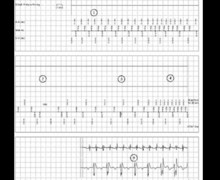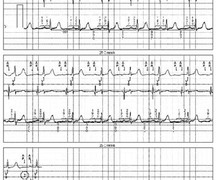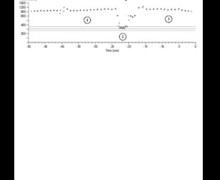Atrial pacing failure
Tracing
Manufacturer Biotronik
Device PM
Field Pacing
N° 18
Patient
81-year-old man implanted with an Evia DR-T dual-chamber pacemaker for complete atrioventricular block; interrogation of the pacemaker 1 year after implantation.

Graph and trace
- ineffective atrial pacing with effective ventricular pacing;
- sensing of spontaneous sinus activity outside of the refractory periods leading to an AV delay and ventricular pacing;
- ineffective atrial pacing and sinus activity falling within the post-atrial atrial blanking, therefore unsensed;
- ineffective atrial pacing and sinus activity falling within the far-field protection period;
- ineffective atrial pacing and sinus activity falling within the PVARP.
Other articles that may be of interest to you







The pacing threshold corresponds to the smallest electrical pulse, delivered outside of all the natural refractory periods, capable of generating the propagation of a depolarization wave. It can be measured in voltage (Volts) or in pulse width (milliseconds). The determination of the pacing threshold is of major importance since the programming of the voltage and duration of the pulse ultimately conditions the safety margin and determines the energy consumption of the prosthesis and therefore the speed of battery wear. It is generally recommended to set a safety margin of 100% which corresponds to a double threshold voltage. This margin of safety is intended to take into account the circadian variations of the pacing threshold, the latter of which are variably influenced, from one subject to another, by sleep, meal intake, physical activity, fever, etc.
This tracing reveals atrial capture failure. The atrial output amplitude was programmed in this patient at 3 Volts for a pulse duration of 0.4 ms. Without any obvious identifiable cause (no lead macro-dislodgement, no metabolic disorder), the pacing threshold had passed beyond this value (threshold at 3.5 Volts for 0.4 ms). Sensing remained appropriate (> 1.5 mV) and pacing impedance normal (470 Ohms). The temporary increase in output amplitude at 4 volts for 0.4 ms solved the problem. In a second phase, the pacing threshold stabilized around 2 Volts for 0.4 ms allowing long-term programming at 3 Volts for 0.4 ms thereby ensuring an acceptable safety margin and energy consumption.